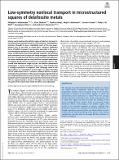Files in this item
Low-symmetry nonlocal transport in microstructured squares of delafossite metals
Item metadata
| dc.contributor.author | McGuinness, Philippa Helen | |
| dc.contributor.author | Zhakina, Elina | |
| dc.contributor.author | König, M | |
| dc.contributor.author | Bachmann, M. D. | |
| dc.contributor.author | Putzke, C. | |
| dc.contributor.author | Moll, P. J. W. | |
| dc.contributor.author | Khim, S. | |
| dc.contributor.author | Mackenzie, Andrew | |
| dc.date.accessioned | 2021-11-16T17:30:03Z | |
| dc.date.available | 2021-11-16T17:30:03Z | |
| dc.date.issued | 2021-11-23 | |
| dc.identifier | 276537859 | |
| dc.identifier | e7efaa01-9e14-4c10-b245-413e74140fa3 | |
| dc.identifier | 85120180092 | |
| dc.identifier | 000727697700001 | |
| dc.identifier.citation | McGuinness , P H , Zhakina , E , König , M , Bachmann , M D , Putzke , C , Moll , P J W , Khim , S & Mackenzie , A 2021 , ' Low-symmetry nonlocal transport in microstructured squares of delafossite metals ' , Proceedings of the National Academy of Sciences of the United States of America , vol. 118 , no. 47 , e2113185118 . https://doi.org/10.1073/pnas.2113185118 | en |
| dc.identifier.issn | 0027-8424 | |
| dc.identifier.uri | https://hdl.handle.net/10023/24344 | |
| dc.description | Funding: Max Planck Society. Engineering and Physical Science Research Council PhD studentship support via grant EP/L015110/1 (PHM,MDB). Deutsche Forschungsgemeinschaft Cluster of Excellence ct.qmat EXC 2147, project-id 390858490. European Research Council (ERC) under the European Union’s Horizon 2020 research and innovation programme (MiTopMat - grant agreement No 715730) (PJWM,CP). | en |
| dc.description.abstract | Intense work studying the ballistic regime of electron transport in two-dimensional systems based on semiconductors and graphene had been thought to have established most of the key experimental facts of the field. In recent years, however, additional forms of ballistic transport have become accessible in the quasi–two-dimensional delafossite metals, whose Fermi wavelength is a factor of 100 shorter than those typically studied in the previous work and whose Fermi surfaces are nearly hexagonal in shape and therefore strongly faceted. This has some profound consequences for results obtained from the classic ballistic transport experiment of studying bend and Hall resistances in mesoscopic squares fabricated from delafossite single crystals. We observe pronounced anisotropies in bend resistances and even a Hall voltage that is strongly asymmetric in magnetic field. Although some of our observations are nonintuitive at first sight, we show that they can be understood within a nonlocal Landauer-Büttiker analysis tailored to the symmetries of the square/hexagonal geometries of our combined device/Fermi surface system. Signatures of nonlocal transport can be resolved for squares of linear dimension of nearly 100 µm, approximately a factor of 15 larger than the bulk mean free path of the crystal from which the device was fabricated. | |
| dc.format.extent | 8 | |
| dc.format.extent | 1473944 | |
| dc.language.iso | eng | |
| dc.relation.ispartof | Proceedings of the National Academy of Sciences of the United States of America | en |
| dc.subject | FIB microstructuring | en |
| dc.subject | Ballistic regime | en |
| dc.subject | Nonlocal transport | en |
| dc.subject | Delafossite | en |
| dc.subject | QC Physics | en |
| dc.subject | QD Chemistry | en |
| dc.subject | DAS | en |
| dc.subject.lcc | QC | en |
| dc.subject.lcc | QD | en |
| dc.title | Low-symmetry nonlocal transport in microstructured squares of delafossite metals | en |
| dc.type | Journal article | en |
| dc.contributor.sponsor | EPSRC | en |
| dc.contributor.institution | University of St Andrews. School of Physics and Astronomy | en |
| dc.contributor.institution | University of St Andrews. Condensed Matter Physics | en |
| dc.identifier.doi | https://doi.org/10.1073/pnas.2113185118 | |
| dc.description.status | Peer reviewed | en |
| dc.identifier.url | https://arxiv.org/abs/2111.00985# | en |
| dc.identifier.grantnumber | EP/L015110/1 | en |
This item appears in the following Collection(s)
Items in the St Andrews Research Repository are protected by copyright, with all rights reserved, unless otherwise indicated.

